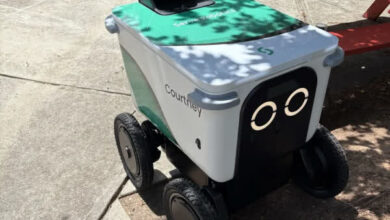The Download: the future of music AI, and climate tech funding

This is today’s edition of The Download, our weekday newsletter that provides a daily dose of what’s going on in the world of technology.
Training AI music models is about to get very expensive
AI music is suddenly in a make-or-break moment. On June 24, Suno and Udio, two startups that let you generate complete songs from a prompt in seconds, were sued by major record labels. The labels alleged the startups had used copyrighted music as training data “at an almost unimaginable scale”.
Just two days later, the Financial Times reported that YouTube is pursuing a comparatively above-board approach. Rather than training AI music models on secret data sets, the company is reportedly offering unspecified lump sums to top record labels in exchange for licenses to use their catalogs for training data.
While the ground here is moving fast, none of these moves should be all that surprising: litigious training-data battles have become something like a rite of passage for generative AI companies. The trend has led many to pay for licensing deals while the cases unfold.
But the stakes of a fight over training data for AI music are different—and arguably even higher. Read our story to find out why, and what might happen next.
—James O’Donnell
These climate tech companies just got $60 million
Every few years, the US agency that’s often called the “energy moonshot factory” announces big funding awards for a few companies to help them scale up their technology. (The agency’s official name is the Advanced Research Projects Agency—Energy, or ARPA-E.)
The grants are designed to help companies take their tech from the lab or pilot stage and get it out into the world. The latest batch of these awards was just announced, totaling over $63 million split between four companies. Read our story that digs into the winners and examines what each one’s technology says about their respective corners of climate action.
—Casey Crownhart
This story is from The Spark, our weekly newsletter giving you the inside track on all things climate tech. Sign up to receive it in your inbox every Wednesday.
Lego bricks are making science more accessible
Etienne Boulter walked into his lab at the Université Côte d’Azur in Nice, France, one morning with a Lego Technic excavator set tucked under his arm. His plan was simple yet ambitious: to use the pieces of the set to build a mechanical cell stretcher.
Boulter and his colleagues study mechanobiology—the way things like stretching or compression affect cells—and this piece of equipment is essential for his research. Commercial cell stretchers cost over $50,000. But one day, after playing with the Lego set, Boulter and his colleagues found a way to build one out of its components for only a little over $200.
Their Lego system stretches a silicone plate where cells are growing. This process causes the cells to deform and mimics how our own skin cells stretch. And Boulter is not alone. In fact, he’s one of many researchers turning to Lego components to build inexpensive yet extremely effective lab equipment. Read the full story.
—Elizabeth Fernandez
This story is from the latest issue of MIT Technology Review, which explores the theme of Play.
The must-reads
I’ve combed the internet to find you today’s most fun/important/scary/fascinating stories about technology.
1 The Supreme Court ruled the White House can contact social media firms
It’s a blow for right-wing campaigners who argue their views are being censored online. (WP $)
+ Here’s what it means for the election. (NPR)
+ Russian propagandists are promoting deepfakes of Biden. (Wired $)
2 How AI has revolutionized protein science
And the most exciting part? We’re really only at the beginning of discovering what machine learning could unlock. (Quanta $)
+ Google DeepMind’s new AlphaFold can model a much larger slice of biological life. (MIT Technology Review)
3 Inside California’s green energy revolution
The state is showing how you can run a thriving modern economy on clean energy. (New Yorker $)
4 Toys ‘R’ Us used OpenAI’s video AI system Sora to make a commercial
It’s a milestone for the use of AI in video production—but the response to it was very mixed. (NBC)
+ I tested out a buzzy new text-to-video AI model from China. (MIT Technology Review)
5 Secret Telegram channels are providing refuge for LGBTQ+ people in Russia
Up to and including advice on how to leave the country, which is becoming less and less safe. (Wired $)
6 We really need AI to be able to cite its sources
The trouble is, even if it could, would they be factually accurate? (The Atlantic $)
+ At least 10% of scientific research may already be co-authored by AI. (The Economist $)
7 Consultants are raking it in thanks to the AI boom
But of course they are. (NYT $)
8 It’s become worryingly normalized to snoop on your partner’s online life
Yet it’s still a really, really bad idea. (WP $)
9 Lawn Mowing Simulator is the latest anti-escapist video game
Struggling to see the appeal personally, but hey, each to their own. (The Guardian)
10 McDonalds has rejected plant-based burgers 🍔
After tests of its McPlant burger in San Francisco and Dallas failed. (Quartz $)
+ Here’s what a lab-grown burger tastes like. (MIT Technology Review)
Quote of the day
“There’s no question that this crosses a line that they hadn’t previously crossed. I think that suggests that the lines are becoming meaningless.”
—Darren Linvill, a founder of the Media Forensics Hub at Clemson University, tells the New York Times that aggressively targeting a US-based Chinese dissident’s 16-year-old daughter online represents a new low for the country’s security services.
The big storyThink that your plastic is being recycled? Think again.

MICHAEL BYERS
October 2023
The problem of plastic waste hides in plain sight, a ubiquitous part of our lives we rarely question. But a closer examination of the situation is shocking.
To date, humans have created around 11 billion metric tons of plastic, the vast majority of which ends up in landfills or the environment. Only 9% of the plastic ever produced has been recycled.
To make matters worse, plastic production is growing dramatically; in fact, half of all plastics in existence have been produced in just the last two decades.
So what do we do? Sadly, solutions such as recycling and reuse aren’t equal to the scale of the task. The only answer is drastic cuts in production in the first place. Read the full story.
—Douglas Main
We can still have nice things
A place for comfort, fun and distraction to brighten up your day. (Got any ideas? Drop me a line or tweet ’em at me.)
+ Enjoy these award-winning black-and-white photos.
+ Is owning a pet good for you? On balance, it seems so!
+ I just learned that there’s more than one type of aurora.
+ Tis the season for potato salad, and this recipe is so good.


